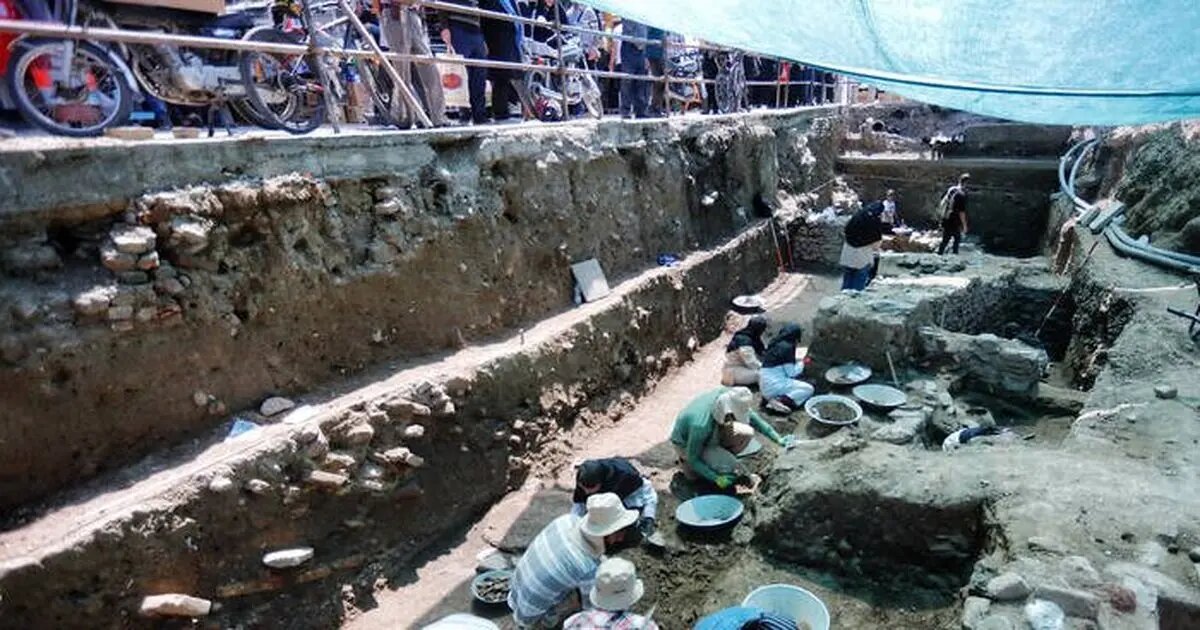Continuous human settlement in Hamedan confirmed from Achaemenid era to Present

THERAN – Archaeologists conducting excavations at the Baba Taher pedestrian pathway in Hamedan have uncovered evidence of continuous human settlement in the area dating from the Achaemenid period (circa 550–330 BC) to the present day, according to local experts.
The excavation, which began in May last year during municipal infrastructure work, aimed to prepare the site for the country’s first open-air museum along Baba Taher Street. However, the project has stalled, and the uncovered area has suffered damage from rainfall and improper use as a waste disposal site.
“We focused initially on stratigraphic analysis of this part of Hamedan, followed by archaeological excavation to support the transformation of the pedestrian way into a site museum,” said the lead archaeologist of the project, Hossein Shabani.
During the dig, the team discovered architectural remains dating back to the Islamic Middle Ages, specifically the Seljuk and Timurid periods (11th to 15th centuries). Among these was a residential building with a water supply system using a small canal, which remained in use until the Qajar era (1789–1925).
“The archaeological structures include multiple rooms with distinct uses and kitchen hearths inside,” Shabani said. “This provides a comprehensive example of Islamic architectural styles in Hamedan spanning several centuries.”
The site also yielded artifacts from the Ilkhanid period (13th-14th centuries), featuring a building constructed from river stones and slabs.
“The excavations confirmed a continuous sequence of human habitation here from the Achaemenid era through Islamic periods to modern times,” Shabani added.
Historically known as Ecbatana, Hamedan was the capital of the ancient Median Empire and served as a summer residence for Achaemenid kings who ruled Persia from 553 to 330 BC. Ancient Greek historians such as Xenophon and Polybius describe the city’s palace complex as richly decorated with cedar and cypress wood plated with gold and silver.
Despite its historical significance, little remains visible from antiquity, and much of the city center has been subjected to archaeological digs. Early excavations began in the early 20th century by French and German-American archaeologists.
The team plans to complete the open-air museum project by the end of summer 2025, pending preservation of the site.
Ecbatana is widely believed to be once a mysterious capital of Medes. According to ancient Greek writers, the city was founded in about 678 BC by Deioces, who was the first king of the Medes.
French Assyriologist Charles Fossey (1869 – 1946) directed the first excavation in Tepe Hegmateneh for six months in 1913. Erich Friedrich Schmidt (1897 – 1964), who was a German and American-naturalized archaeologist, took some aerial photos from Hamedan between 1935 and 1937.
According to the Greek historian Xenophon of Athens (c.430-c.355), Ecbatana became the summer residence of the Achaemenid kings. Their palace is described by the Greek historian Polybius of Megalopolis. He writes that the city was richer and more beautiful than all other cities in the world; although it had no wall, the palace, built on an artificial terrace, according to Livius, a website on ancient history written and maintained since 1996 by the Dutch historian Jona Lendering.
Furthermore, an inscription unearthed in 2000 indicates that Achaemenid king Artaxerxes II Mnemon (404-358) built a terrace with columns in Ecbatana. Some twelve kilometers southwest of Hamedan is Ganjnameh, where Darius I and his son Xerxes had inscriptions cut into the rock.
Polybius, a Greek historian of the Hellenistic period noted for his work The Histories, tells that the builders used cedar and cypress wood, which was covered with silver and gold. The roof tiles, columns, and ceilings were plated with silver and gold. He adds that the palace was stripped of its precious metals in the invasion of the Macedonian king Alexander the Great and that the rest was seized during the reigns of Antigonus and Seleucus. Later, Ecbatana was one of the capitals of the Seleucid and the Parthian Empires, sometimes called Epiphaneia.
Around 1220, Hamedan was destroyed by the Mongol invaders. In 1386, it was sacked by Timur (Tamerlane), a Turkic conqueror, and the inhabitants were massacred. It was partly restored in the 17th century and subsequently changed hands often between Iranian ruling houses and the Ottomans.
AM
Leave a Comment